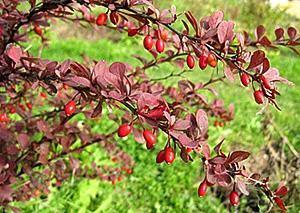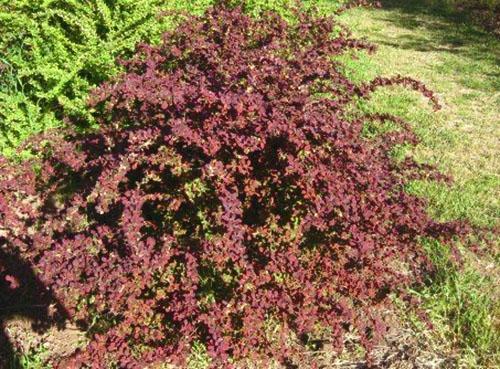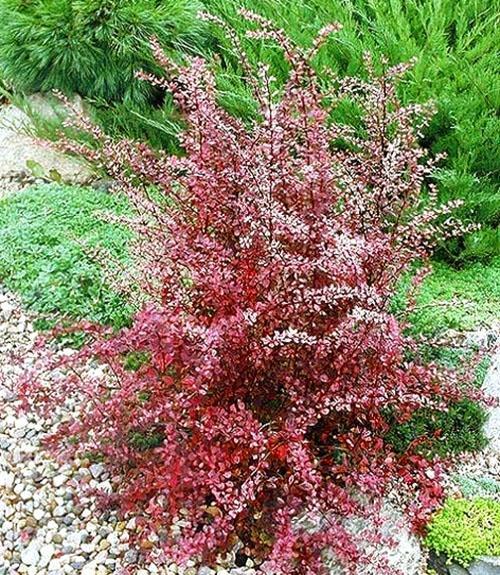Planting and caring for red-leaved barberry in the garden
 So, you joined the number of those who decided to plant red-leaved barberry on their site or in the garden. Planting and caring for this plant is not particularly difficult, however, in order for the plant to feel comfortable, you need to know a few basic rules.
So, you joined the number of those who decided to plant red-leaved barberry on their site or in the garden. Planting and caring for this plant is not particularly difficult, however, in order for the plant to feel comfortable, you need to know a few basic rules.
Choosing a place for planting purple-leaved barberry

The natural habitat of the plant in question is dry mountain slopes, which is why let the soil be better poor in organic matter, but in no case - not acidic and not too wet. Ideal for planting barberry shrub - light soil or loam, without water stagnation and with good drainage. With too much proximity to groundwater, cultivation is unlikely to be successful.
Read also the article about barberry Thunberg!
Planting common purple barberry
 If the planting site is chosen and ready, you can proceed: as soon as the soil thaws from winter frosts (before the buds begin to bloom), immediately plant the prepared plants.
If the planting site is chosen and ready, you can proceed: as soon as the soil thaws from winter frosts (before the buds begin to bloom), immediately plant the prepared plants.
Experts say that it is possible to transplant barberry during the autumn leaf fall, but in this case it will be much more difficult for the plant.
The whole planting process is a few simple sequential steps:
- Preparing the holes: the size of the hole directly depends on the age of the bush. If he is up to three years old, it is enough to make a hole with a diameter of a quarter of a meter and about the same depth, but for older bushes, the parameters increase to half a meter.

- The hole prepared for planting the common purple barberry is filled with a fertile substrate. It can be obtained by mixing equal amounts of compost or humus with garden soil and sand.
If the purpose of planting barberry is to set up a hedge, do not dig holes, but a trench 40 cm deep, which you also fill with a substrate.
- If your site consists of loamy or clayey soils, liming before planting bushes (300 g of lime per bush).
- The only fertilizer that should be applied when planting is superphosphate... Spread it over the soil at the rate of 100 g for each barberry bush.
Watering and fertilizing purple barberry
 Barberry in the garden, a photo of which shows how beautiful this plant looks externally, is very easy to grow. Its great advantage lies in the fact that it is undemanding to watering: water is needed only during planting and once a week thereafter. But you should constantly loosen the soil under the bushes - this will not only improve its structure, but also provide the roots with good air access.
Barberry in the garden, a photo of which shows how beautiful this plant looks externally, is very easy to grow. Its great advantage lies in the fact that it is undemanding to watering: water is needed only during planting and once a week thereafter. But you should constantly loosen the soil under the bushes - this will not only improve its structure, but also provide the roots with good air access.
If, for various reasons, you do not have the opportunity to constantly loosen the soil under the barberry bushes, be sure to mulch it with sawdust, peat or shredded nutshells!
 The fertilizers that you applied during planting are enough for the bushes to take root and develop successfully during the first year of life. But starting from the second, the barberry already needs feeding. It has its own for each season:
The fertilizers that you applied during planting are enough for the bushes to take root and develop successfully during the first year of life. But starting from the second, the barberry already needs feeding. It has its own for each season:
- Spring is very important nitrogen fertilizer (2 g of urea per liter of water), watering the bushes with slurry with water in a ratio of 1: 5, or bird droppings with water 1:10.
- Summer feeding consists in the introduction of granular complex fertilizers containing microelements.
- At the very beginning of autumn, 10 grams of any potash fertilizer and 15 grams of superphosphate must be scattered under each barberry bush. In this case, you will get strong and healthy bushes of purple barberry - photos taken by gardeners allow you to notice the differences between fertilized bushes and those that grow by themselves.
How to prepare bushes of red-leaved barberry for winter?
 Unlike some heat-loving varieties of this plant, such a barberry does not need to be wrapped in sacking for the winter, however, it is still better to take care of protecting young bushes or seedlings. As a rule, they are covered with needles, foliage or spruce branches.
Unlike some heat-loving varieties of this plant, such a barberry does not need to be wrapped in sacking for the winter, however, it is still better to take care of protecting young bushes or seedlings. As a rule, they are covered with needles, foliage or spruce branches.
If the cover is placed not directly on the soil, but on a fine mesh, it can be very easily removed in the spring.
They cover the bushes after the soil freezes to a depth of 5 cm, and the ambient temperature does not rise above five degrees of frost for more than 7 days.
The bushes should be freed from covering in the spring not only carefully so as not to damage the kidneys, but also in a timely manner, otherwise their growth may slow down. The exact time depends on where the barberry grows, since spring does not come to all regions at the same time.
Pruning purple barberry and pest control
 Barberry growers argue that pruning is the most difficult part of caring for it. The fact is that the shoots of the plant are quite prickly, and especially in a dried form, when, in fact, they need to be removed. Therefore, it is better to stock up on thick long gloves. Removal is carried out in the spring; not only dry, but also weak, sick, frost-damaged shoots are subject to it - they can be easily recognized by the absence of green foliage.
Barberry growers argue that pruning is the most difficult part of caring for it. The fact is that the shoots of the plant are quite prickly, and especially in a dried form, when, in fact, they need to be removed. Therefore, it is better to stock up on thick long gloves. Removal is carried out in the spring; not only dry, but also weak, sick, frost-damaged shoots are subject to it - they can be easily recognized by the absence of green foliage.
 If your barberry grows for a hedge, then you can cut it after flowering and until the very cold, excluding the period when the barberry ripens - the berries will crumble.
If your barberry grows for a hedge, then you can cut it after flowering and until the very cold, excluding the period when the barberry ripens - the berries will crumble.
 Unfortunately, barberry bushes are liked by all sorts of pests, and they can also suffer from some diseases. Here are just a few signs of a problem and how to fix it:
Unfortunately, barberry bushes are liked by all sorts of pests, and they can also suffer from some diseases. Here are just a few signs of a problem and how to fix it:
- Shrinking and drying of healthy leaves is a sign of the presence of a barberry aphid. You can get rid of it either with the help of special preparations, or by folk methods: infusion of garlic, hot pepper, etc.
- White bloom on the leaves indicates powdery mildew damage. This is one of the most popular diseases in this plant. it is easier to prevent than to get rid of it later: every three weeks, starting from the moment the leaves bloom, spray the bushes with a 0.5% solution of colloidal sulfur. If you doubt that your barberry is healthy, photos of plants infected with powdery mildew can always be found in special sources and a comparison can be made.
- Bright orange spots are a sign of rust or fusarium. A neglected disease leads to the death of shoots and whole bushes. To avoid this, at the first manifestations, spray the bushes with a 1.5% solution of colloidal sulfur or a 3% solution of Bordeaux liquid.
- Barberry bacteriosis is one of the most common causes of barberry cancer. It begins with the appearance of dark oblong spots. Bushes die without timely measures. To avoid this, spray the bushes twice (before and after flowering) with a 4% solution of copper oxychloride.